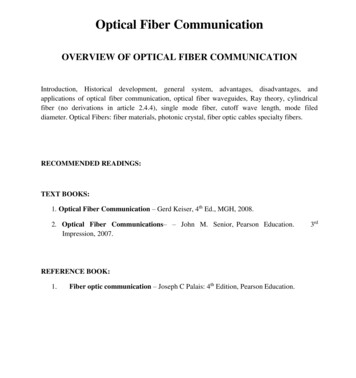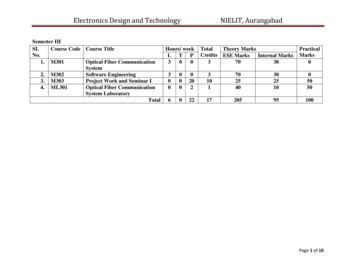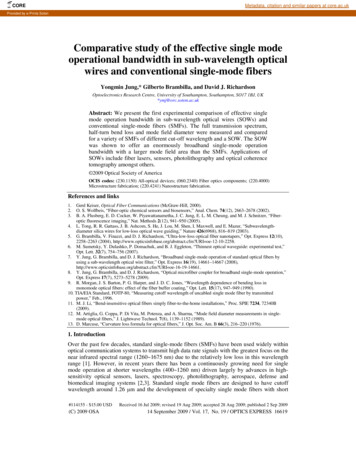
Transcription
Continue
Optical communication essentials gerd keiser pdf bookThis means that we need to have at least V/s 13.0 (22.3 dB). The link from the ONU to the customer premises can be a twisted-pair copper wire, a coaxial cable, an independent optical fiber link, or a wireless connection. On the other hand, destructive recombination results in the two signal halves canceling each other so there is no light at theoutput of the beam combiner. Ali, A. In addition, liquid crystals have the further benefit of being tunable using external electric fields.53a Depending on the fluid and the fiber material, inserting fluids into photonic crystal fiber holes can be achieved by simply submerging one PCF end-facet into a liquid reservoir, while leaving the other end-facet opento atmospheric pressure.53b 2.8.2 Photonic Bandgap Fiber Photonic bandgap (PBG) fibers have a different light-guiding mechanism, which is based on a twodimensional photonic bandgap in the transverse plane of the cladding region. Passive WDM couplers perform the wavelength combining and separation functions. Paek, “Strength of fusionsplices for fiber lightguides,” Electron. Since each of the two possible polarization directions can be coupled with either a cos jf or a sin jf azimuthal dependence, four discrete mode patterns can be obtained from a single LPjm label. Although this process works well for moderate-speed single-wavelength operation, it can present a data transmissionbottleneck for high-speed multiple-wavelength systems. Example 3.1 An ideal fiber would have no loss so that Pout Pin. Thus for practical applications the variations in the combined EDFA-plus-Raman gains can be compensated for either by employing fast clamping of only the EDFA gain or by means of a simple feedforward gain-control methodthat uses the total input signal power as the feed signal to adjust the Raman pump powers. 63, pp. Optics, vol. Thus for direct detection Eq. (8.31) becomes I DD Es Es* 1 2 A 2 s (8.32) At the receiving end in coherent lightwave systems, the receiver first adds a locally generated optical wave to the incoming information-bearing signal and thendetects the combination. Daikoku, I. Wide Area Network (WAN) A WAN spans a large geographical area. Geittner and H. 21. In this case, RIN dominates at high powers, quantum noise gives a 1-dB drop in C/N for each 1-dB power decrease at intermediate levels, and receiver thermal noise yields a 2-dB C/N roll-off per 1-dB drop in received power atlow light levels Of these, AM is simple and cost-effective in that it is compatible with the equipment interfaces of a large number of CATV customers, but its signal is very sensitive to noise and nonlinear distortion. If the probabilities of 0 and 1 pulses are equally likely [that is, a b 0.5 in Eq. (7.8)], then Eqs. For gaussian-shaped beams the lossbetween identical fibers is62 LSM, lat d 2 10 log exp w (5.40) where the spot size w is the mode-field radius defined in Eq. (2.74), and d is the lateral displacement shown in Fig. System standards refer to measurement methods for links and networks. For higher data rates one needs to use a device calledan external modulator to temporally modify a steady optical power level emitted by the laser (see Sec. As an example, the four possible 62 Optical Fiber Communications Fig. Two main technologies to make a tunable filter are MEMS-based and Bragg-grating-based devices. This condition is defined as the time at which the device can no longer emit afixed power level (1.25 mW in this case) at the 70 C heat-sink temperature. Usually fewer wavelengths are carried on metro and access network links, but the traffic patterns can be bursty and wavelengths often can be added or dropped depending on customers’ demand for service. 2004–2010 tester, a visual fault indicator for locating breaksEXFO Inc.) and failures in a fiber cable, and a talk set for full-duplex communications between field personnel. Find the values of x for the following experimental measurements on dissimilar amplifiers where dBc is the power relative to the carrier: CTB1 (dBc) CTB2 (dBc) CTBcascade (dBc) -75.2 -69.9 -70.5 -74.7 -71.4 -71.0 -72.1 -71.3 -66.7 9.10Consider a subcarrier-multipiexed CATV distribution system that has N channels. 5.8a. 2.47 A cable plowing machine that is used in a nonurban environment. 13.27 An ONT intended for indoor installation requires a 12-V dc power supply and consumes 15 W of electric power during normal operation. Let both the insertion loss and the throughput lossof each FBG be 0.25 dB, and let the insertion loss of a circulator be 0.6 dB. Simsarian, A. If the optical power level is 10 mW, then from Eq. (6.6) the photocurrent generated is Ip RPin (0.65 A/W)(10 mW) 6.5 mA values are 0.65 A/W for silicon at 900 nm and 0.45 A/W for germanium at 1.3 mm. When D 1 we have that k12 k22 β 2 . Most otherdegradation effects can be sufficiently reduced or eliminated. 50 20 10 5 Fiber: a 25 mm 2 1 Fig. Kodialam, V. The couplers have a power tapoff factor of CT 5 percent and a 10-percent fractional intrinsic loss Fi. The power loss at the connectors is 20 percent (1 dB). These include Snell’s law, the definition of the refractive index of a material, andthe concepts of reflection, refraction, and polarization. 540 Optical Fiber Communications Table 13.8 Data formats and protocols that need to be accommodated by a metro WDM network Format or protocol Data rate OC-3/OC-3c and STM-1/STM-1c OC-12/OC-12c and STM-4/STM-4c OC-48/OC-48c and STM-16/STM-16c OC-192/OC-192c and STM64/STM-64c Fast Ethernet Gigabit Ethernet (GigE) 10-Gigabit Ethernet (10GigE) ESCON Fibre Channel Digital video 155 Mb/s 622 Mb/s 2.488 Gb/s 9.953 Gb/s 125 Mb/s 1.25 Gb/s 10 Gb/s 200 Mb/s 133 Mb/s to 1.06 Gb/s 270 Mb/s Since the add/drop functions can change dynamically from node to node, special components, such as a variableoptical attenuator (VOA), are needed to equalize the power levels of newly added wavelengths with those that already are on the fiber. For guided modes, b can assume only certain discrete values, which are determined from the requirement that the mode field must satisfy Maxwell’s equations and the electric and magnetic field boundary conditionsat the core-cladding interface. The conditions required for total internal reflection can be determined by using Snell’s law [Eq. (2.16)]. 2.28 Distribution of light in a single-mode fiber above its cutoff wavelength. Using b 2p n/l for the propagation constant from Eq. (2.46), we have m 2 Ln L ν λ 2n c (4.40) where c nl. This can be done withalarm surveillance, which involves reporting alarms that may have different levels of severity and indicating possible causes of these alarms. Timing jitter is an especially important issue for high-speed optical fiber transmission systems because pulses are spaced very close together. Here, we look first at passive multiplexers. Table 10.4 lists someoperational characteristics of commercially available circulators. The term ONT in this figure refers to the transceiver equipment at the customer location. The horizontal axis denotes the distance between the instrument and the measurement point in the fiber. In area A1 the numerical aperture is limited by that of the emitting fiber, whereas in areaA2 the numerical aperture of the receiving fiber is smaller than that of the emitting fiber. To achieve a high quantum efficiency, the depletion layer must be thick enough to permit a large fraction of the incident light to be absorbed. The exact same reconfiguration scenario will occur when the primary fiber connecting nodes 3 and 4 breaks. This isknown as codirectional pumping. Consider a fiber with a 25-mm core radius, a core index n1 1.48, and D 0.01. 2.1.1 Linear Polarization The electric or magnetic field of a train of plane linearly polarized waves traveling in a direction k can be represented in the general form A(r, t) ei A0 e xp[ j (wt - k r)] (2.1) with r xex yey zezrepresenting a general position vector and k kxex kyey kzez representing the wave propagation vector. The goal of this book is to describe the various technologies, implementation methodologies, and performance measurement techniques that make optical fiber communication systems possible. 13.55, in such a dispersion compensator thegrating spacing varies linearly over the length of the grating. Geerinck, S. 516–519, May 1986. Gupta, S. Lee, C.-L. 2.51b. 2.18 are denoted by solid lines and their associated constant-phase fronts by dashed lines. Each LP1m mode comes from TE0m, TM0m, and HE2m modes. 6.18 Absorption coefficient of Si as a function of wavelength M 0,max V B nRM Ip 12 274 Optical Fiber Communications 6.5 Consider a sinusoidally modulated optical signal P(t) of frequency w, modulation index m, and average power P0 given by P(t) P0(1 m cos w t)2 Show that when this optical signal falls on a photodetector, the mean-square signal current is2 generated consists of a dc (average) componentIp and a signal current ip given by is2 I 2p i 2p (R P0 )2 1 ( mR P0 )2 2 where the responsivityR is given by Eq. (6.6). The upper layers support user applications by structuring and organizing data for the needs of the user. 122. The acceptable signal-to-noise ratio then is Smin/N. n bits Remainder CRC Remainder Step 3. 6.13d. Koonen,“Bit-error-rate degradation in a multimode fiber optic transmission link due to modal noise,” IEEEJ. 80–94, Apr. L Koch, eds., Optical Fiber Telecommunications–III., vol. A simple approach is to divide the number Ne of errors occuring over a certain time interval t by the number Nt of pulses (ones and zeros) transmitted during this interval. Jeffery andH. Such cables serve low- to medium-fiber-count applications where it is necessary to protect individual jacketed fibers. 4296–4303, Nov. Using Eq. (4.31), this threshold value can be expressed in terms of the threshold current Jth needed to maintain an inversion 178 Optical Fiber Communications level n nth in the steady state when the number ofphotons F 0: nth τsp Jth (4.33) qd This expression defines the current required to sustain an excess electron density in the laser when spontaneous emission is the only decay mechanism. Chang, Y. However, most wavelength measurements are quoted in terms of wavelengths or optical frequencies in a vacuum. 11.4 shows a typical gain versuswavelength characteristic for a device with a peak gain of 25 dB at 1530 nm. 11.14 Measured EDFA noise figure under gain saturation for codirectional pumping and counterdirectional pumping at 1480 nm. Then, the tuning range is Δλtune λ Δneff neff (1550 nm ) (0.0065) 10 nm If the source spectral width Dlsignal is 0.02 nm for a 2.5-Gb/ssignal, then using Eqs. 817–828, IEEE, May 1995.) Nonlinear Effects 12.4 473 Stimulated Brillouin Scattering Stimulated Brillouin scattering arises when a strong optical signal generates an acoustic wave that produces variations in the refractive index.1,3,4–10 These index variations cause lightwaves to scatter in the backward direction towardthe transmitter. Table D-1 Power ratio dB D.2 Examples of decibel measures of power ratios 10N 10 2 1 10N 10 3 0 0.5 -3 0.1 10-N -10 -10N The dBm The decibel is used to refer to ratios or relative units. 8.14 shows the dramatic reduction in chirping penalty when using a dispersion-shifted fiber, or when combining fibers with positive andnegative dispersion. WDM systems,” J. Also, the design of the receiver becomes more complex because the tolerance to frequency drifts between the transmit laser and the delay interferometers is six times lower than for DPSK. Electrically there are many ways of sending a given digital message.18–22 One of the simplest techniques for sendingbinary data is amplitude-shift keying (ASK) or on-off keying (OOK), wherein a voltage level is switched between two values, which are usually on or off. Intrinsic absorption by the basic constituent atoms of the fiber material. ITU-T Recommendation X.210 14. Figure 4.29 shows one mirror system that consists of a semiconductor material, such asSi/SiO2, as one material and an oxide layer, such as Si/Al2O3, as the other material. 122–154, Apr. The basic motivations behind each new system application were (a) to improve the transmission fidelity so that fewer distortions or errors occur in the received message, (b) to increase the data rate or capacity of a communication link so that moreinformation can be sent, or (c) to increase the transmission distance between in-line repeater or amplification stations so that messages can be sent farther without the need to restore the signal amplitude or fidelity periodically along its path. In addition, since modal-distortion-limited bandwidth is difficult to equalize, it is best to choose a single-modefiber. After a certain amount of overlap occurs, the receiver can no longer distinguish the individual adjacent pulses and errors arise when interpreting the received signal. 2006. Attached to a metro network is the access network, which consists of links between end users and a central office. J. However, in the first case, wavelength reuse andnetwork scalability (expandability) are reduced, and in the second case the add/drop flexibility of the OXC is lost. 25 26. This noise decreases as the injection-current level increases according to the relationship I RIN B 1 I th 3 (9.9) Vendor data sheets for 1550-nm DFB lasers typically quote RIN values of –152 to –158 dB/Hz.Substituting the CNRs resulting from Eq. (9.4) through Eq. (9.7) into Eq. (9.1) yields the following carrier-to-noise ratio for a single-channel AM system: 1 ( mR M P )2 C 2 N RIN(R P )2 Be 2q( I p ID ) M 2 F ( M ) Be ( 4 kBT Req ) Be Ft 9.2.4 (9.10) Reflection Effects on RIN In implementing a high-speed analog link, one must take specialprecautions to minimize optical reflections back into the laser.2 Back-reflected signals can increase the RIN by 10–20 dB as shown in Example 9.1 Figure 9.3 shows an example of Eq. (9.9) for two buried-heterostructure lasers.13 The noise level was measured at 100 MHz. For injection currents sufficiently above threshold (i.e., for IB/Ith 1.2), theRIN of these index-guided lasers lies between –140 and -150 dB/Hz. 355 Analog Links 1 2 – 120 RIN (dB/Hz) – 130 – 140 – 150 – 160 1.0 1.4 1.8 2.2 IB/Ith Fig. This decoupling between header or label processing and payload switching allows the packets to be routed independent of payload bit rate, coding format, and packet length. Here, the zerosignal gain (or small-signal gain) is G0 30 dB, which is a gain factor of 1000. 14.38 for a non-mode-coupled fiber. For splices, the separation losses are normally negligible as the fibers should be in relatively close contact. Alping, “RF transmission over multimode fibers using VCSELs—Comparing standard and highbandwidth multimode fibers,” J.Assume the gap s 1 mm and the face angle q 8 . The book website ( describes current offerings available on vendor websites of the demonstration modules that the reader may download and learn from.55 Problems 1.1 (a) What are the energies in electron volts (eV) of light at wavelengths 850, 1310, 1490, and 1550 nm? A signal passes throughthree cascaded amplifiers, each of which has a 5-dB gain. 4.16 Frequency response of an optical source showing the electrical and optical 3-dB-bandwidth points An optical source exhibits a linear relationship between light power and current, so currents rather than voltages (which are used in electrical systems) are compared in optical systems.Section 8.3.4 gives an overview of Reed-Solomon codes used in FEC techniques. 4.43 Short and long wavelength WDM use Datacom applications using 1G Ethernet and 1x/2x Fibre Channel Telecom applications using OC-3/STM-1, OC-12/STM-4, and OC-48/STM-16 across all distances Distances from short links up to 160 km Seven standardoptical fiber transceiver packages and their features. The OC-12 is passed through and the two OC-3s are dropped by the first ADM. 19. The fabrication of this device is similar to the Fabry-Perot types, except that the lasing action is obtained from Bragg reflectors (gratings) or periodic variations of the refractive index (called distributedfeedbackcorrugations), which are incorporated into the multilayer structure along the length of the diode. In contrast to the 1 1 protection method, in the 1:N protection scheme traffic is transmitted only over the working fiber in normal operation. First, a small portion of the external photons will be absorbed by ions in the ground state, which raises theseions to the metastable level, as shown by transition process 6. The cables often are based on fiber-ribbon configurations, which are available with up to 864 optical fibers housed in a cable structure that is less than one inch (24.4 mm) in diameter (see Fig. Duelk, J. 14.8). Workers can install optical fiber cables by pulling or blowing them through ducts(both indoor and outdoor) or other spaces, laying them in a trench outside, plowing them directly into the ground, suspending them on poles, or laying or plowing them underwater. The resulting power saving is called the coding gain. To compensate for the accumulated ASE noise, the signal power must increase at least linearly with the length of thelink in order to keep a constant signal-to-noise ratio. 13.6.1 looks at general OXC configurations, Sec. Mrotek, M. Lumish, N. The first element is either a pin or an avalanche photodiode, which produces an electric current that is proportional to the received power level. δ tan N 2 n2 cos 2 θ1 1 δp n2 cos 2 θ1 1 tan 2 n n sin θ1 sin θ1 (2.19a)Solving for j2 then yields j2 sin–1 (0.329) 19.2 . 1.1 gives the motivations behind the development of optical fiber transmission systems. The fiber flylead is terminated with an LC optical connector. This protection method provides rapid switchover during failures and does not require a protection signaling protocol between the source anddestination. Mirshafiei, J. Briefly, intermodal dispersion can be described as follows. 4, pp. Two important characteristics of a photodetector are its quantum efficiency and its response speed. In the ensuing years an increasingly larger portion of the electromagnetic spectrum was utilized to develop and deploy progressively more sophisticated andreliable electrical communication systems with larger capacities for conveying information from one place to another. The glass soot adheres to this bait rod and, layer by layer, a cylindrical, porous glass preform is built up. Kao for his pioneering insight into using glass fibers as a medium for data transmission and for his enthusiastic internationalfollow-ups in promoting the further development of low-loss optical fibers. This spectral band is called the long-wavelength region. Since InP is used as the material for an EAM, it can be integrated onto the same substrate as a DFB laser diode chip. The shapes of two signal probability distributions are shown in Fig. As noted earlier, the total carrierpopulation is determined by carrier injection, spontaneous recombination, and stimulated emission. A number of vendors offer such light sources that generate a true single-mode laser line for every selected wavelength point. Miller, “Analysis of digital modulation on optical carriers,” in D. 4.24 An optical source is selected from a batch characterizedas having lifetimes that follow a slow internal degradation mode. Since the optical power that can be coupled into a fiber depends on the radiance (i.e., on the spatial distribution of the optical power), the radiance of an optical source rather than the total output power is the important parameter when considering source-to-fiber coupling efficiencies.In addition to using silica, polymer and soft glass materials, such as PMMA and SF6 or SF57 Schott (lead silicate) glass, also have been used to make photonic crystal fibers.53,71–76 For these fiber types the preform is made by an extrusion process. In addition, the rationale for using harmonic functions is that any waveform can be expressed in termsof sinusoidal waves using Fourier techniques. If the device initially emits 1 mW at room temperature, what is the expected optical output power after (a) 1 month of operation, (b) after 1 year, and (c) after 3 years? L.39, Investigation of the soil before using trenchless techniques, May 2000 Describes soil-investigation techniques for obtaininginformation about the position of buried objects and the nature of the ground. Conceptually, the WDM scheme is the same as frequency division multiplexing (FDM) used in microwave radio and satellite systems. Masuda, S. 14.22 Two specifications for dead zone are the event dead zone and the attenuation dead zone. 1 8 . Stegun, Handbook ofMathematical Functions, Dover, New York, 10th ed., 1972. Kristensen, C. Kaneko, J.-I. Both the time-domain and frequency-domain dispersion measurements assume that the fiber behaves quasi-linearly in power; that is, the individual overlapping output pulses from an optical waveguide can be treated as adding linearly. Khoe, and A.M.J. Koonen,“Hybrid radio-over-fiber and OCDMA architecture for fiber to the personal area network,” J. Polarization-mode dispersion results from the fact that light-signal energy at a given wavelength in a single-mode fiber actually occupies two orthogonal polarization states or modes (see Sec. Chandrasekhar, L. 6.7 Comparisons of Photodetectors This sectionsummarizes some generic operating characteristics of Si, Ge, and InGaAs photodiodes. Itoh, “Arc fusion splicer with profile alignment system for high-strength low-loss optical submarine cable,” J. For the fractional-loss method, we use the notation Pj,k to denote the optical power received at the detector of the kth station from the transmitter of thejth station. Takagi, S.-I. The ability for the user to interact with the program during a simulation. pp. 250–253 quantum efficiency, 252–253 responsivity, 252–253, 272 reverse bias circuit, 249 Planck’s constant, 6 Planck’s law, 6 Plane of incidence, 34–35 Plane of vibration, 29 Plane wave, 28–29 Plasma-activated chemical vapor deposition (PCVD)process, 76–77 Plastic optical fibers, 71 Plesiochronous digital hierarchy, 12 PMD (see Polarization-mode dispersion) PMD compensation, 556–557 PMD penalty, 318–319 pn junction, 151, 156–157, 159, 161, 174, 177 Point-to-point link, 305–315 attenuation limit, 314–315 component choices for, 305–306 dispersion limits, 317–319 link power budget,306, 307–309, 313–315 rise-time budget, 306, 310–313 short-wavelength band, 313–314 single-mode links, 314–315 system considerations, 306–307 Poisson distribution, 281 Polarization: Brewster’s angle, 37 circular, 31–33 devices, 38–39 elliptical, 31–33 linear, 29–30 materials, 38–39 parallel component, 37–38 perpendicular component, 37–38state, 39 unpolarized, 36–37 Polarization-mode dispersion, 116, 119, 126–127, 556–557 Polarization-mode dispersion compensation, 556–557 Polarization-mode power penalty, 318–319 Polarization-preserving fiber, 143–144 Polarizer, 38, 396–397 walk-off polarizer, 39, 396–398 Polymer optical fibers, 71 Polynomial error-detection codes, 329–331PON, 540–548, 550–553 Population inversion, 171, 174–175 Postcompensation for dispersion, 554 Power coupling calculation, 213–216 Power launching versus wavelength, 216–217 Power map, 554–555 Power penalty, 316–318 ASE noise, 452 chirp penalty, 323–325 chromatic dispersion penalty, 316–318 definition, 316 extinction ratio penalty, 319,324 modal noise penalty, 319–321 mode-partition noise penalty, 322–323 PMD penalty, 318–319 reflection noise penalty, 325–327 Preamplifier noise, 353–354 Precompensation for dispersion, 554 Preform, 74–75 Probability density function, 284 Probability distribution, 283–284 Probability of error, 277–278, 285–286, 294 Protocol, 497, 540 Protocolstack, 497– 498 p-type material, 154–156 Public network, 495– 496 Pump laser, 432, 439, 456– 459 Pump wave, SRS, 471 Pumping, 171, 175, 437– 441, 443– 445 Q factor, 463 Q factor estimation, 607–609 Index Q-parameter, 285–288, 293–294 Q-factor technique, 294 Quality of service (QoS), 498 Quantum efficiency, 165–168 external, 167–168internal, 166 optical source, 165–168 Quantum limit, 290–291 Quantum nature of light, 33 Quantum well laser, 184–185 Radiance, 159–160, 577 Radio frequency bands, 364 Radio transmission, 3– 4 Radio-over-fiber, 368–370 Raman amplification, 431– 432, 456– 459 broadband gain, 457– 458 distributed amplifier, 432, 457 gain coefficient, 456– 457lumped amplifier, 432, 457 pump wavelengths, 457– 458 Stokes shift, 456 Ray congruence, 42 Ray optics, 28 Ray tracing, 28 Rayleigh scattering, 109–110 Receiver: analog, 297–300 digital, 283–291 sensitivity, 278, 287–290, 296–297 sensitivity ranges, SONET, 511–512 Recombination, 151, 154–157 lifetime, 165 region, 151 Reconfigurable OADM(ROADM), 521, 523–528 (see also OADM) Reduced-cladding fiber, 143–144 Reed-Solomon code, 332 Reflection, 34–36, 45– 46 angle of incidence, 34–36 external, 35 internal, 35 total internal, 35 Reflection coefficient, 215 Reflection grating, 399, 423 Reflection noise power penalty, 325–327 Reflectivity, etalon, 403– 406 651 Refraction, 34–36Refractive index, 33–34 core-cladding index difference, 43, 65 parabolic profile, 68–69 profile, 41, 68–69 values of, 34 Refractive index difference, 43– 45, 68–69 in graded-index fibers, 68–69 in step-index fibers, 43– 45 Relative intensity noise (RIN), 354–356, 357–358, 363, 366, 371 Resonant cavity filter, 403– 404 Responsivity: for avalanchephotodiodes, 256 in pin photodiodes, 252–253 typical values, 272 Return loss, 384–385, 391, 398, 406, 407, 411, 414 Return-to-zero (RZ) code, 195–196 RF over fiber, 364–368 associated noise powers, 365–366 key link parameters, 364–366 limiting conditions, 366 noise figure, 365 spur-free dynamic range, 366–368 RIN (see Relative intensity noise)Ring network, 493, 499–501, 511–515, 537 Rise-time budget, 306, 310–313 RZ code, 195–196 S-band, 7–9 SBS (see Stimulated Brillouin scattering) SBS threshold, 473– 474 Scattering loss, 108–111 Scattering matrix, 385–387 Scrambling, 196 SDH, 13–14, 507–516 (see also SONET/SDH) Second window, 8–9 Self-phase modulation, 469, 475– 476,485 Kerr effect, 475– 476 Kerr nonlinearity, 475– 476 nonlinear index coefficient, 475– 476 (see also Nonlinear effects) Semiconductor optical amplifier (SOA), 433– 437 (see also Optical amplifiers) 652 Service provisioning on the fly, 523 Service type, 12 Severely errored seconds, 332 Shannon capacity formula, 24 Short band, 7 Short-wavelengthband, 7–9 Signal dispersion, 114–127 Signal modulation, 352–353 Signal-to-noise ratio, 257, 261–262, 279–280, 283, 286–288, 297–300 Simplex, 503 Simulation tools, 20–23 Single-mode fiber, 41, 59, 65–68, 128–138 1300-nm-optimized, 128–130 bending loss in, 111–113, 135–138 cutoff wavelength, 49, 58, 130–133 depressed cladding, 128–130dispersion, 124–126, 128–130 dispersion calculation, 132–135 dispersion-flattened, 128–130 dispersion-shifted, 128–130 large-effective core area (LEA), 129–130 matched-cladding, 128–130 material dispersion, 115, 121–123 mode-field diameter, 65–67 nonzero dispersion-shifted, 128–130 propagation modes, 67–68 refractive-index profiles, 128–130signal distortion, 124–126 total dispersion, 128–131 waveguide dispersion, 115–116, 123–124 Single-mode laser, 182 (see also Laser diode; Optical source) Sinter, 74 Skew ray, 43– 44 (see also Light ray) Small form factor (SFP) transceiver, 202–203, 516–517 Small-wavelength limit, 42 Snell’s law, 34–36, 44 SNR (see Signal-to-noise ratio) SOAbandwidth, 436– 437 (see also Optical amplifiers) Soliton, 482– 488 characteristics of, 482– 483 fundamental, 482, 484– 486 GVD versus Kerr nonlinearity, 483– 485 Index higher-order, 482 hyperbolic secant pulse shape, 485 nonlinear Schrödinger equation, 484 soliton parameters: collision length, 490 dispersion length, 484, 486– 488 interactiondistance, 488 oscillation period, 488 peak power, 486 pulse separation, 87 pulse width, 486, 488 soliton period, 487 soliton pulse, 483– 485 SONET, 13–14, 507–516 architectures, 511–515 comparison to SDH, 507–509 line, 508 maximum power per wavelength, 511–512 multiplexing, 12–14 optical interfaces, 509–511 path, 508 path overhead, 508–510 receiver sensitivity ranges, 511–512 section, 508 standards for 507–511 STM frame, 508–510 STS frame, 508 STS-N signals, 508–509 synchronous payload envelope (SPE), 508–509 transmission distances, 511–512 transmission formats, 508–509 transmission rates, 508–509 SONET/SDH networks, 515–516 add/drop multiplexing in, 515–516architectures, 515 transmission rates, 509, 515–516 WDM configuration, 516 SONET/SDH rings, 511–515 architectures, 511–514 bidirectional, 511, 513 failure reconfigurations, 514 line switching, 512 loop diversity, 511 path switching, 512 protection path, 513–514 self-healing, 511–512 unidirectional, 511–513 Index Space charge region, 156Spatial walk-off polarizer, 39 Specialty fibers, 142–144 Speckle noise, 320 Spectral bands, 5–9 Spectral slicing, 152, 419, 421 Spectral width, 377–378, 379, 410, 420 Speed of light, 6 Splicing, 232–235 definition, 233 for single-mode fibers, 234–235 techniques, 232–233 Splitting loss, 391 SPM (see Self-phase modulation) Spontaneous emission, 170,176, 438– 439, 445– 446 Spot size, 66–67 Spur-free dynamic range, 364, 366–368 SRS (see Stimulated Raman scattering) Standards, 19–20, 138–142, 379–381, 571–573 component testing, 572 FTTP fibers, 140 ITU-T Recommendations for fibers, 138–142 measurement, 571–573 multimode fibers, 138–139 organizations, 19, 517–518 WDM, 379–381Star coupler, 391–393 splitting loss, 391–392 Star network, 499–501, 506–507 State of polarization (SOP), 39 Step-index fiber, 40– 41, 43 Stimulated Brillouin scattering, 468– 469, 473– 475 (see also Nonlinear effects) Stimulated emission, 170–171, 176, 431, 433, 438, 439 Stimulated Raman scattering, 469, 471– 472 (see also Nonlinear
Optical communication essentials gerd keiser pdf book This means that we need to have at least V/s 13.0 (22.3 dB). . , and polarization. 540 Optical Fiber Communications Table 13.8 Data formats and protocols that need to be accommodated by a metro WDM network Format or protocol Data rate OC-3/OC-3c and STM-1/STM-1c OC-12/OC-12c and STM-4 .










